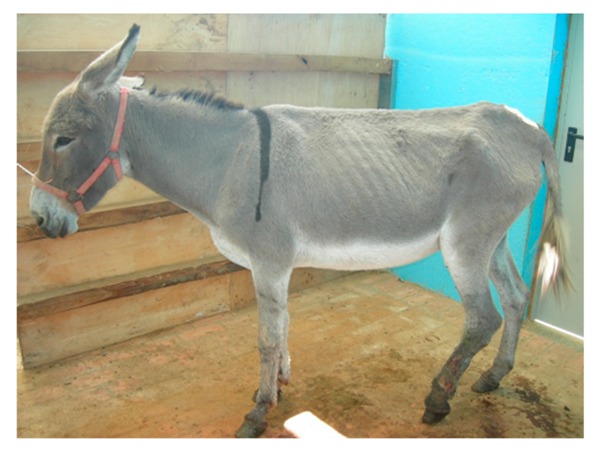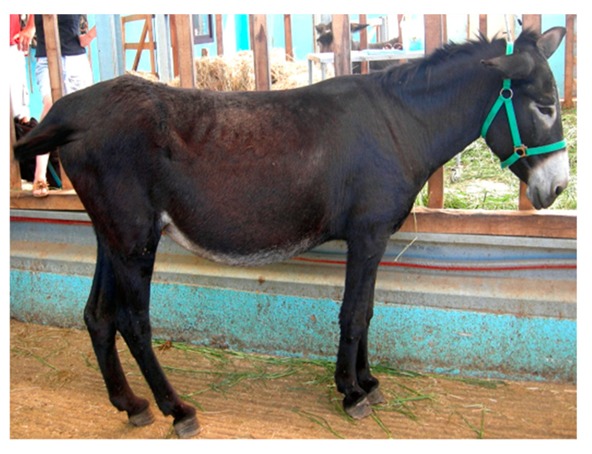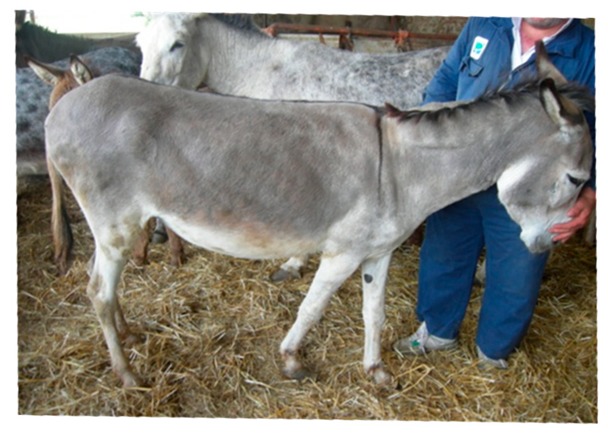Table 6.
Comparison of the two body condition scoring systems for donkeys. Adapted from Pearson and Ouassat [57] and The Donkey Sanctuary [22]. The images in the table are the authors’ own.
| Body Condition Scoring for Donkeys | ||||
|---|---|---|---|---|
| Scale From 1 to 9 | Scale From 1 to 5 | |||
| 1. Very thin (Emaciated) | Bone structure easily seen over body. Little muscle present. | 1. Poor | Neck thin and it meets the shoulders abruptly. Shoulders angular. All bones easily felt. Dorsal spine of the withers and backbone prominent. Dorsal and transverse processes easily felt. Ribs can be seen from a distance and felt easily. Belly tucked up. Little muscle covering on the hindquarters. There may be a cavity under the tail. |

|
| 2. Thin | Bone structures are prominent and sharply defined. Neck thin and shoulders sharply angular. Some muscle development. | |||
| 3. Less thin | Little muscle or fat covering the bone structures, which can be felt easily. Loin area and rump concave. | 2. Moderate | Some muscle development overlying the bones, which can be felt easily. Slight step on neck-shoulder junction. Some covering over the dorsal withers. Spinous processes may be felt but are not prominent. Ribs, dorsal/transverse processes and hips not visible, but can be felt easily. |

|
| 4. Less than moderate | Vertebral column visible. Withers, shoulders and neck have some muscle and fat covering. Pins can be felt but not visible. Hooks rounded but visible. Rump flat rather than concave. | |||
| 5. Moderate | Hooks and rump rounded. Pins not visible. Some fat can be felt in the shoulder area and at the base of the neck. Ribs may be felt, but not visible. | 3. Ideal | Good muscle development. Bones felt under light covering of the muscle/fat. Neck flows smoothly into the shoulders, which are rounded. Ribs just covered by a slight layer of fat/muscle. Ribs can be felt. Spinous and transverse processes cannot be felt. Hip bones rounded in appearance, and can be felt |

|
| 6. More than moderate | Spinous processes cannot be felt easily. Rump convex and well-muscled. Some fat can be felt on the neck. | 4. Fat | Neck thick. Crest hard. Shoulders covered in an even fat layer. Withers broad, bone felt with firm pressure. Dorsal ribs only felt with firm pressure; ventral ribs may be felt more easily. Bone structure can only be felt with firm pressure. Belly overdeveloped. |

|
| 7. Less fat | Spinous processes cannot be felt. Hooks just visible. Fat on neck and shoulders is beginning to expand over the rick. Neck thickening. | |||
| 8. Fat | Animal appears well covered and with a rounded body but no fat or bones are discernible. Flanks filled, broad back. | 5. Obese | Neck thick, crest bulging with fat and falling to one side. Shoulders bulging with fat. Withers broad. Bone structures cannot be felt. Ribs not palpable. Belly pendulous in depth and width. Back broad. Spinous and transverse processes cannot be felt. Deep crease along midline and bulging fat either side. |

|
| 9. Very fat | Bones buried in fat. Large accumulations of fat on the neck, over the shoulder area and on the ribs. Flank filled with fat. | |||
